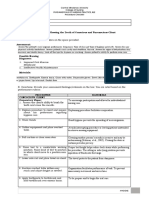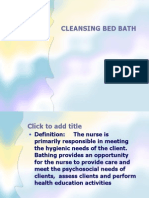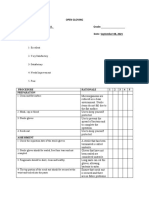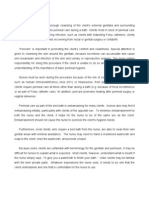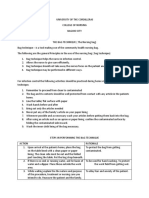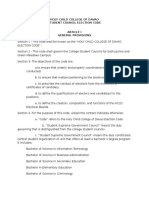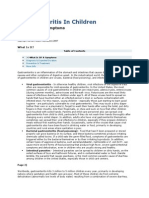Shampooing Hair or Shampoo in Bed
Shampooing Hair or Shampoo in Bed
Uploaded by
Charm BoiserCopyright:
Available Formats
Shampooing Hair or Shampoo in Bed
Shampooing Hair or Shampoo in Bed
Uploaded by
Charm BoiserOriginal Description:
Copyright
Available Formats
Share this document
Did you find this document useful?
Is this content inappropriate?
Copyright:
Available Formats
Shampooing Hair or Shampoo in Bed
Shampooing Hair or Shampoo in Bed
Uploaded by
Charm BoiserCopyright:
Available Formats
SHAMPOOING HAIR OR SHAMPOO IN BED Hair accumulates the same dirt and oil as the skin.
It should be washed as often as necessary to keep it clean. A weekly shampoo may be sufficient for some persons whereas others may prefer to perform this aspect of personal hygiene daily. The nurse may need to shampoo the hair of those clients who cannot get out of bed for bathing and showering or who lack of strength or ability to independently care for their hair. PURPOSES OF PROCEDURE Shampooing of hair is done to: 1. Cleanse the hair and scalp. 2. Maintain or improve self esteem. 3. Treat conditions of the scalp with topical applications of medications 4. Remove substances such as blood, body secretions, or electrode jelly (used when an electroencephalogram or other such study is done) ASSESSMENT OBJECTIVE DATA: *Examine the hair; note its distribution, cleanliness, texture and any indications of parasitic infection, such as the nits of head, lice on the hair shaft * Inspect the scalp for lacerations, dry scaly patches, scratches, lesions and swollen areas. * Observe the client for signs of any itchy scalp, such as scratching the head. * Note the signs of dandruff on the shoulders and back of clothing. * Determine if the client is receiving toxic chemotherapy or radiation treatments that may cause loss of hair. * Read the clients medical record to determine if the client has any pathology, such as hypothyroidism, or is receiving long-term steroid therapy that may alter the texture and distribution of hair * Identify if there are any sensory, cognitive, endurance, mobility, or motivational deficit that interferes with the clients ability to perform hygiene practices. SUBJECTIVE DATA: * Ask the client to describe the usual routine for shampooing, including the frequency and types of hair care products routinely used. * Inquire if the client experiences any itching, burning, or tenderness of the scalp. * Note the clients history of hair or scalp problems and related treatments. RELEVANT NURSING DIAGNOSIS: Those clients who need assistance with shampooing are likely to have the following nursing diagnoses: * Self-care deficit * Disturbance in Self Concept *Altered Health maintenance * Unilateral Neglect PLANNING ESTABLISHING PRIORITIES When blood or body fluids, such as emesis, collect in the hair, the nurse should thoroughly sponge the areas as soon as possible. Care of the scalp and accessory structures, such as the hair, helps maintain the integrity of the skin a s a barrier to infection and trauma. Personal hygiene practices should always be considered an important aspect of preventive care. Since appearance is linked to self-esteem, regular shampooing also meets higher level needs. SETTING GOALS: * The clients hair and scalp will be free of dirt, oil and other substances. *The hair will be dried and combed free of tangles. * The client will express feelings of well-being and satisfaction about his appearance. PREPARATION OF EQUIPMENT: The nurse should assemble the following items: Several towels Hair care products, such as shampoo, conditioner, mousse, setting gel, or petroleum (optional) Water pitcher Shampoo through Bath blanket Absorbent pad Comb/hairbrush Hair dryer (optional) ahocampo
TECHNIQUE FOR SHAMPOOING HAIR: ACTION: 1. Explain the procedure to the client. RATIONALE: An explanation facilitates understanding and cooperation. Handwashing deters the spread of microorganism. Organization is a form of appropriate time-management and prevents fatigue and frustration of the client. Adjusting the bed helps to prevent muscle strain or fatigue. A supine position facilitates drainage away from the face, eyes and head. Removing tangles before washing will prevent Breaking strands of hair. Layered material absorbs water and prevents the client from feeling wet and chilled. It also avoids Saturating the bed linen.
2. Wash your hands. 3. Assemble the equipment near the client.
4. Raise the bed to a height convenient for you and Lower the nearer side rail. 5. Position the client on the back.
6. Comb or brush the clients hair.
7. Place a folded bath blanket, several towels, or an Absorbent pad under the clients head, shoulders and back.
8. Place a plastic tray or through, under the clients head. Using a through provides a method for collecting and draining the water away from the client and the bed. 9. Lay a towel or bath blanket over the clients chest And shoulders. 10. Wet the hair thoroughly with warm water 11. Work the shampoo into a lather The edge can be used to wipe away any water that Splashes the clients face or ears. Wet hair dilutes the shampoo and helps to form suds. Lathering helps distribute the shampoo throughout the entire head of hair for uniform cleansing. Rinsing prevents leaving shampoo in the hair, which gives hair a dull appearance; if left on the scalp, shampoo could cause irritation for some people. Towels absorb water, beginning the process of drying while allowing the client to assume a more comfortable position. Discarding the water and the equipment will prevent accidental spilling Loosening and combing the hair prepare it for styling. Most clients prefer to style the hair in order to make it attractive as well as clean Precautionary measures prevent falls and injury to the client Handwashing deters the spread of microorganism. Careful recording is important for planning and individualizing the clients care
12. Rinse the hair with clean, running water
13. Wrap the clients head with dry towels.
14. Remove the equipment used for shampooing.
15. Fluff the hair with towels and comb out the hair. 16. Braid blow dry, or set the hair
17. Raise the side rail and lower the bed when leaving The client. 18. Wash your hands 19. Document the assessments, care provided, the clients Ability to participate and the clients response
EVALUATION REASSESSMENT: Inspect the condition of the hair and scalp during daily physical assessment. Ask the client if the current plan for hygiene is satisfactory and meets expectation. Revise the plan for care when goals are unachieved.
ahocampo
You might also like
- CMO-No.30-s2001 BSN Old CurriculumDocument37 pagesCMO-No.30-s2001 BSN Old CurriculumCharm Boiser100% (2)
- Nursing Care of Patients Undergoing Orthopedic SurgeryDocument86 pagesNursing Care of Patients Undergoing Orthopedic Surgeryoliver wiafe67% (12)
- Bed Bath Procedure and RationaleDocument10 pagesBed Bath Procedure and Rationaleira Genelazo80% (5)
- Bed Making-Unoccupied ChecklistDocument2 pagesBed Making-Unoccupied ChecklistClaire Ravago67% (3)
- Procedure in Making An Occupied BedDocument7 pagesProcedure in Making An Occupied Bedcrrfrnc77% (13)
- Rationale For Surgical HandwashingDocument2 pagesRationale For Surgical HandwashingPhil Pasaol100% (1)
- Oral Care Procedure and RationaleDocument5 pagesOral Care Procedure and RationaleKaye Naig100% (2)
- Shampoo in BedDocument19 pagesShampoo in BedNorman Batalla Juruena, DHCM, PhD, RN93% (14)
- Bed Making RationaleDocument4 pagesBed Making RationaleMart Alunan0% (1)
- Brushing and Flossing The Teeth of Conscious and Unconscious Client Procedure ChecklistDocument3 pagesBrushing and Flossing The Teeth of Conscious and Unconscious Client Procedure ChecklistMONIQUE GONZALESNo ratings yet
- Open Gloving W/ RationaleDocument4 pagesOpen Gloving W/ RationaleMacy Dysanco100% (1)
- Bathing An Infant - ChecklistDocument2 pagesBathing An Infant - ChecklistVivi rikkaNo ratings yet
- Performance Checklist - Perineal CareDocument2 pagesPerformance Checklist - Perineal CareAlhadzra AlihNo ratings yet
- Bag Technique: Nursing Procedure Rationale RemarksDocument3 pagesBag Technique: Nursing Procedure Rationale RemarksADOLF FRUELAN HIDALGO100% (2)
- Making An Occupied BedDocument13 pagesMaking An Occupied BedKim Ramos100% (1)
- Iran CultureDocument16 pagesIran CultureReza MohagiNo ratings yet
- Hair CareDocument11 pagesHair Carepreeti sharmaNo ratings yet
- Hair Care and Foot CareDocument6 pagesHair Care and Foot CareKelsey MacaraigNo ratings yet
- Share Care of Hair - WPS OfficeDocument5 pagesShare Care of Hair - WPS OfficeSuneel Kumar PrajapatiNo ratings yet
- CHECKLIST-On-Shampooing Patient's Hair in Bed265Document2 pagesCHECKLIST-On-Shampooing Patient's Hair in Bed265Blessie Fernandez0% (1)
- Shampooing Hair in Bed Procedure ChecklistDocument3 pagesShampooing Hair in Bed Procedure ChecklistGLORY MI SHANLEY CARUMBANo ratings yet
- Steps Rationale: 1. AssessDocument2 pagesSteps Rationale: 1. AssessNathalieCaraca100% (1)
- Shampooing Hair in Bed PurposesDocument3 pagesShampooing Hair in Bed PurposesDuchess Juliane Jose MirambelNo ratings yet
- Cleansing Bed BathDocument26 pagesCleansing Bed BathNorman Batalla Juruena, DHCM, PhD, RN94% (18)
- Bed Shampoo Procedure and RationaleDocument3 pagesBed Shampoo Procedure and Rationaleira GenelazoNo ratings yet
- Bed BathDocument4 pagesBed Bathkhaye26100% (3)
- Bed Bath Procedure ChecklistDocument6 pagesBed Bath Procedure ChecklistGLORY MI SHANLEY CARUMBA100% (1)
- Purposes:: Perineal CareDocument4 pagesPurposes:: Perineal CareGodfrey AntolinNo ratings yet
- Bed MakingDocument8 pagesBed MakingV_RN100% (1)
- Steps Rationale: Providing Oral Care (For The Unconscious Client)Document3 pagesSteps Rationale: Providing Oral Care (For The Unconscious Client)NathalieCaraca50% (2)
- Bag Technique: Name: Angeline M. Taghap Grade: Year and Section: BSN 2 B DateDocument11 pagesBag Technique: Name: Angeline M. Taghap Grade: Year and Section: BSN 2 B DateAngeline TaghapNo ratings yet
- Misamis University: Administering Parenteral MedicationsDocument10 pagesMisamis University: Administering Parenteral MedicationsAkio OzaragaNo ratings yet
- Making An Unoccupied BedDocument23 pagesMaking An Unoccupied BedKim RamosNo ratings yet
- Performing Nail and Foot Care - Skill 38-2Document5 pagesPerforming Nail and Foot Care - Skill 38-2Jasmine LarsenNo ratings yet
- Changing An Unoccupied Bed Procedure Checklist 1Document6 pagesChanging An Unoccupied Bed Procedure Checklist 1GLORY MI SHANLEY CARUMBANo ratings yet
- Skills Rationale A. Proper Use of Personal Protective EquipmentDocument4 pagesSkills Rationale A. Proper Use of Personal Protective EquipmentNicole Villanueva, BSN - Level 3ANo ratings yet
- Open GlovingDocument5 pagesOpen GlovingMierre Sirius100% (1)
- TEPID Sponge BathDocument3 pagesTEPID Sponge BathJustJ Things100% (1)
- Foot Care Procedure ChecklistDocument5 pagesFoot Care Procedure ChecklistGLORY MI SHANLEY CARUMBANo ratings yet
- Procedures and RationaleDocument7 pagesProcedures and RationaleMonmon BagarinaoNo ratings yet
- Baby BathDocument7 pagesBaby Bathavinash shindeNo ratings yet
- Shampooing Clients in BedDocument2 pagesShampooing Clients in BedNicole Nipas100% (1)
- Back CareDocument39 pagesBack Carejoslinjohn100% (2)
- Perineal Care FinalDocument9 pagesPerineal Care Finalp4sion100% (2)
- Perilite Exposure JuecoDocument3 pagesPerilite Exposure JuecoTrishaNo ratings yet
- Infant Tub BathDocument3 pagesInfant Tub Bathako at ang exo100% (1)
- Procedure Scientific RationaleDocument3 pagesProcedure Scientific RationaleMichael AmandyNo ratings yet
- 14A Preparing Medications From AmpulesDocument3 pages14A Preparing Medications From AmpulesMarky RoqueNo ratings yet
- 12 Bathing An AdultDocument4 pages12 Bathing An AdultFreisan ChenNo ratings yet
- Worksheet16 GLOVING AND GOWNINGDocument4 pagesWorksheet16 GLOVING AND GOWNINGMarie Ashley CasiaNo ratings yet
- RationaleDocument2 pagesRationalekrissy100% (3)
- Assessment - of - SKIN HAIR AND NAILS CHECKLISTDocument8 pagesAssessment - of - SKIN HAIR AND NAILS CHECKLISTJonah R. MeranoNo ratings yet
- Procedure in Moving Patient From Bed To ChairDocument1 pageProcedure in Moving Patient From Bed To ChaircrrfrncNo ratings yet
- Perineal ShavingDocument17 pagesPerineal ShavingBELIGANIO JOHANNANo ratings yet
- PERINEAL CARE-femaleDocument17 pagesPERINEAL CARE-femaleDarren RobertoNo ratings yet
- Home Visit PlanDocument2 pagesHome Visit Planako at ang exoNo ratings yet
- Serving and Removing of BedpanDocument5 pagesServing and Removing of BedpanJmarie Brillantes Popioco100% (1)
- Po No Breast RationaleDocument4 pagesPo No Breast Rationalearnold john boniteNo ratings yet
- Script Bed Bath YawaDocument4 pagesScript Bed Bath YawaChristina Maxime ValdemorNo ratings yet
- Perineal Care, Fleet Enema, Hot Sitz, Immediate Newborn CareDocument18 pagesPerineal Care, Fleet Enema, Hot Sitz, Immediate Newborn CarekesNo ratings yet
- Bag Technique 2 UCDocument2 pagesBag Technique 2 UCSoleil Maxwell0% (1)
- Procedure For Giving Perineal Care To The Male ClientDocument3 pagesProcedure For Giving Perineal Care To The Male ClientParado Cabañal SkylieghNo ratings yet
- 2 Hair WashDocument7 pages2 Hair Washchintu kashyapNo ratings yet
- 22 and 23 Application For Licensure by ExaDocument2 pages22 and 23 Application For Licensure by ExaCharm BoiserNo ratings yet
- Holy Child College of Davao: Mintal CampusDocument3 pagesHoly Child College of Davao: Mintal CampusCharm BoiserNo ratings yet
- Handbook - Student Council Election CodeDocument10 pagesHandbook - Student Council Election CodeCharm BoiserNo ratings yet
- Sample Exhibit FormDocument14 pagesSample Exhibit FormCharm BoiserNo ratings yet
- MABC 501 ModulesDocument88 pagesMABC 501 ModulesCharm BoiserNo ratings yet
- It Lab SkedDocument2 pagesIt Lab SkedCharm BoiserNo ratings yet
- بطيخة الفارما (antibiotic) PDFDocument31 pagesبطيخة الفارما (antibiotic) PDFweele samaNo ratings yet
- FL Medicaid Managed Care FAQDocument85 pagesFL Medicaid Managed Care FAQJenniferRaePittsNo ratings yet
- Discharge Plan FhayeDocument4 pagesDischarge Plan FhayeTin-Tin RutaquioNo ratings yet
- Session 8: The Role of Human FactorsDocument15 pagesSession 8: The Role of Human FactorsNational Academies of Science, Engineering, and MedicineNo ratings yet
- Deep Learning Implementation For Poultry Disease Detection and ControlDocument11 pagesDeep Learning Implementation For Poultry Disease Detection and ControlInternational Journal of Innovative Science and Research TechnologyNo ratings yet
- Mn003626a01-Af Esla Slr1000 Bsim LacrDocument452 pagesMn003626a01-Af Esla Slr1000 Bsim LacrOscar EscobarNo ratings yet
- The Role of Guidance and Counseling..Document11 pagesThe Role of Guidance and Counseling..Official bimbingan konselingNo ratings yet
- The Impact of Dementia On The ClinicalDocument8 pagesThe Impact of Dementia On The ClinicalihsansabridrNo ratings yet
- Gastroenteritis in ChildrenDocument4 pagesGastroenteritis in ChildrenDennifer MadayagNo ratings yet
- Crystal Hi-Lites Malden Catholic High SchoolDocument80 pagesCrystal Hi-Lites Malden Catholic High SchoolAmanda BeresheimNo ratings yet
- Pharmacy - Professional Regulation Commission Board of PharmacyDocument1 pagePharmacy - Professional Regulation Commission Board of PharmacyBas BaylonNo ratings yet
- Concept Map COPDDocument2 pagesConcept Map COPDnursing concept mapsNo ratings yet
- MutationDocument5 pagesMutationDrRajkumar PatelNo ratings yet
- Short Case - Stoma ExaminationDocument6 pagesShort Case - Stoma Examination张虢袀No ratings yet
- The Rise of Teenage Gangs and Their ConsequencesDocument1 pageThe Rise of Teenage Gangs and Their ConsequencesNaisa HondilayNo ratings yet
- Carigara National High School: School Safety Assessment ToolDocument70 pagesCarigara National High School: School Safety Assessment ToolLourd Edmond Carlisle DantesNo ratings yet
- GEA Westfalia Separator Soline: Advanced Soymilk ProcessingDocument12 pagesGEA Westfalia Separator Soline: Advanced Soymilk ProcessingbanerjeeamlanNo ratings yet
- Antacids: Synthetic vs. Natural: A Project OnDocument16 pagesAntacids: Synthetic vs. Natural: A Project OnArpit mahatoNo ratings yet
- Seizure: Health Education HFT 201 By: Sophia Kol, MDDocument12 pagesSeizure: Health Education HFT 201 By: Sophia Kol, MDTith SeavmeyNo ratings yet
- Fabrication of MF ProsthesesDocument29 pagesFabrication of MF ProsthesesAmit GaurNo ratings yet
- Peace Corps Micronesia Welcome Book - June 2011Document47 pagesPeace Corps Micronesia Welcome Book - June 2011Accessible Journal Media: Peace Corps DocumentsNo ratings yet
- Risk Assessment Determining The Level of RiskDocument3 pagesRisk Assessment Determining The Level of RiskpoojaupesNo ratings yet
- 2 Marking Period Recovery Activity - Eleventh GradeDocument2 pages2 Marking Period Recovery Activity - Eleventh GradeJuan Jose HerreraNo ratings yet
- Nature Descriptive EssayDocument3 pagesNature Descriptive Essayafhbfqccp100% (2)
- National Building Code of The PhilippinesDocument16 pagesNational Building Code of The PhilippinesMr LawlietNo ratings yet
- NABH - 5th Edition Audit PointsDocument4 pagesNABH - 5th Edition Audit PointsqualitykinderNo ratings yet
- TGI Spring (April 2024)Document6 pagesTGI Spring (April 2024)The Livingston County NewsNo ratings yet
- Putting Texas FirstDocument113 pagesPutting Texas FirstProgressTXNo ratings yet









